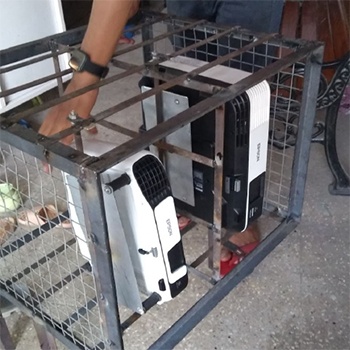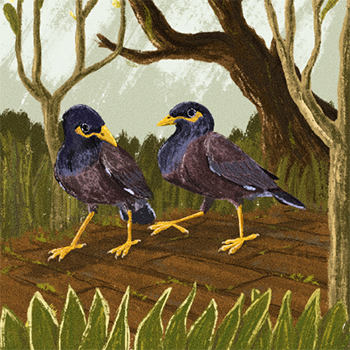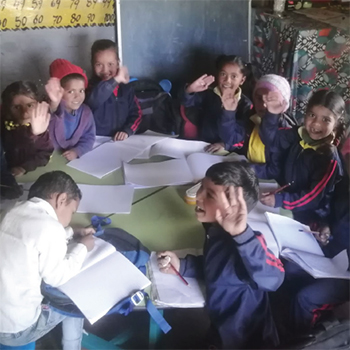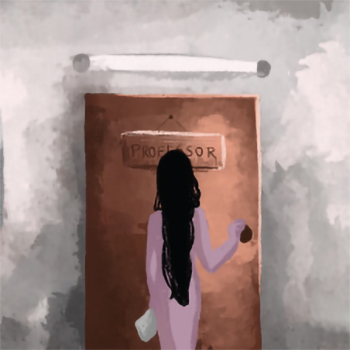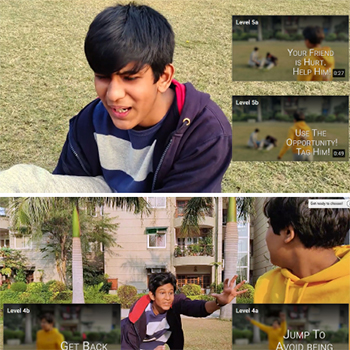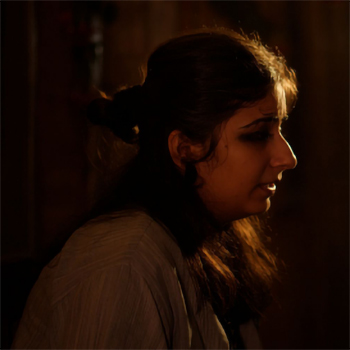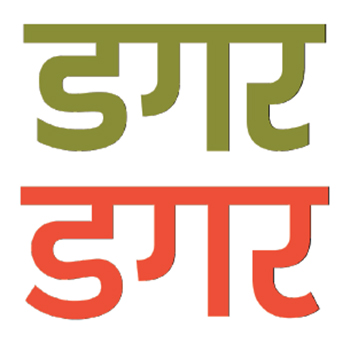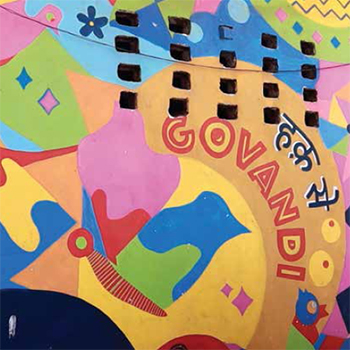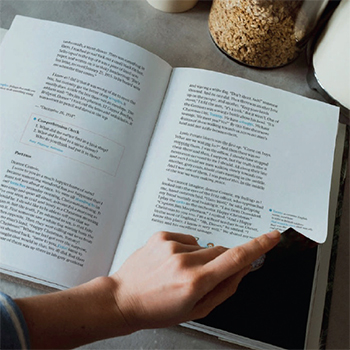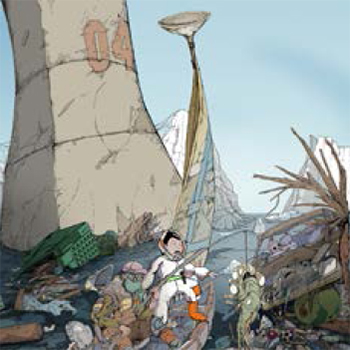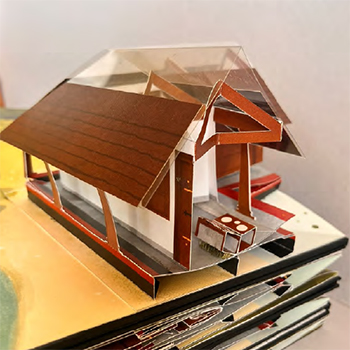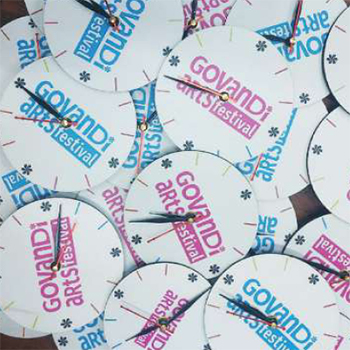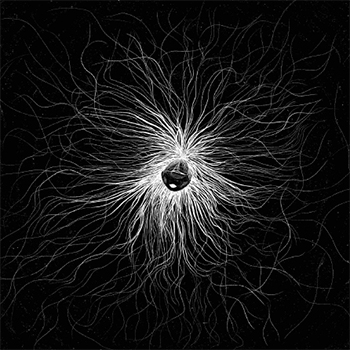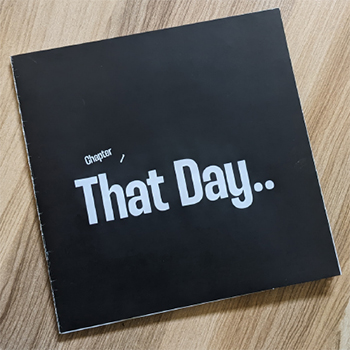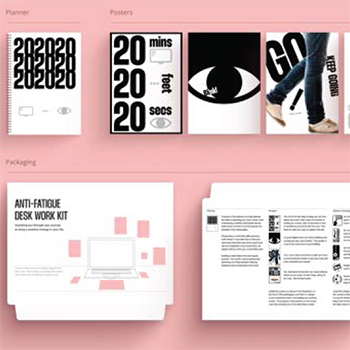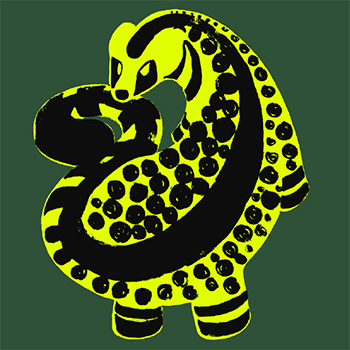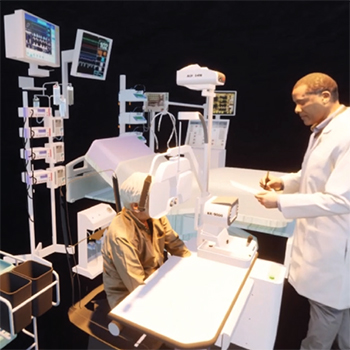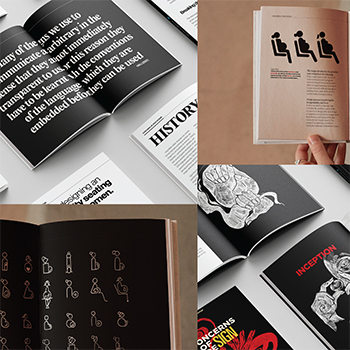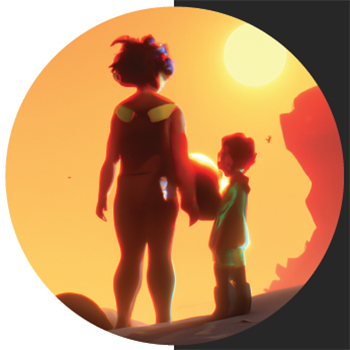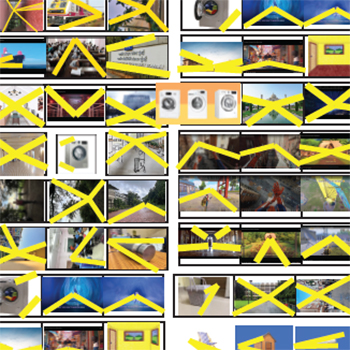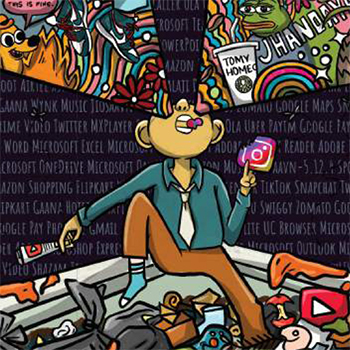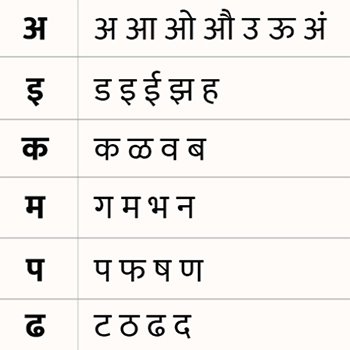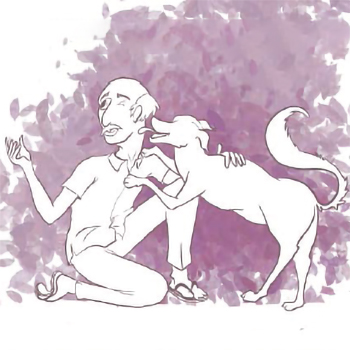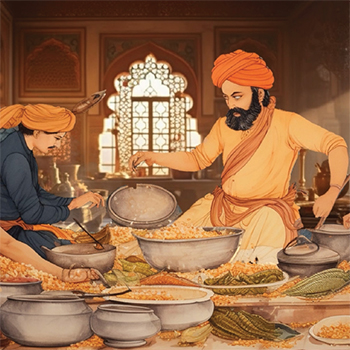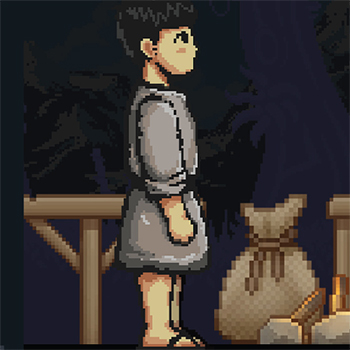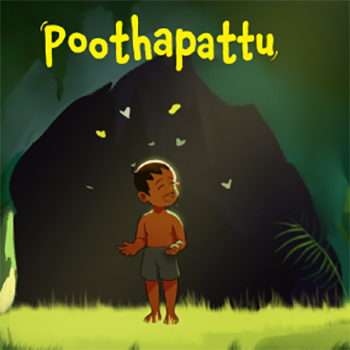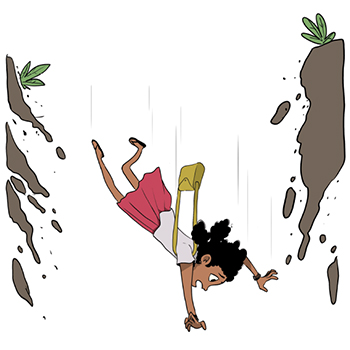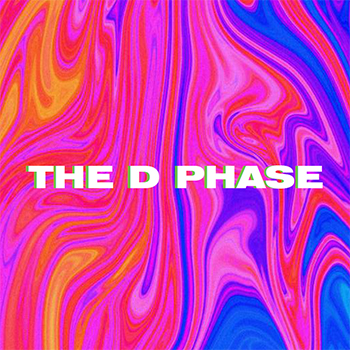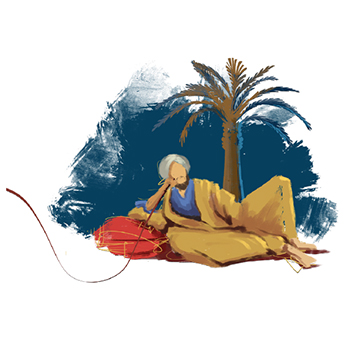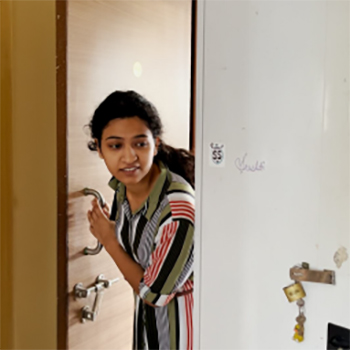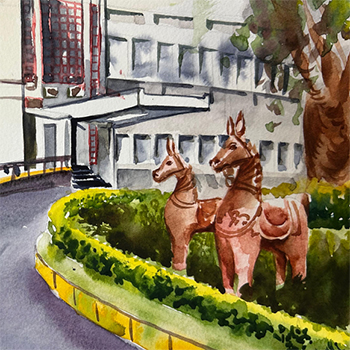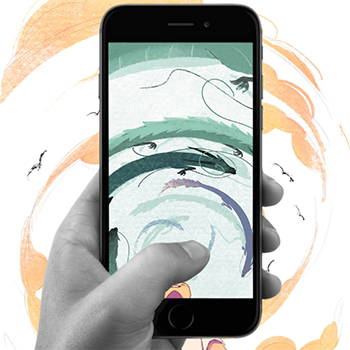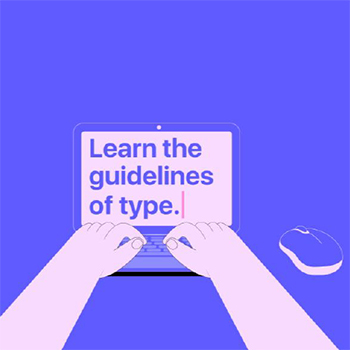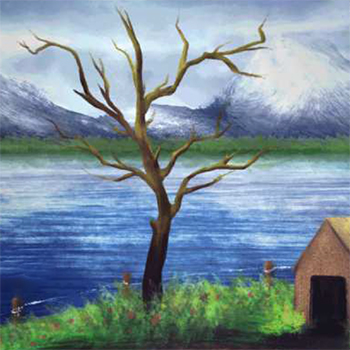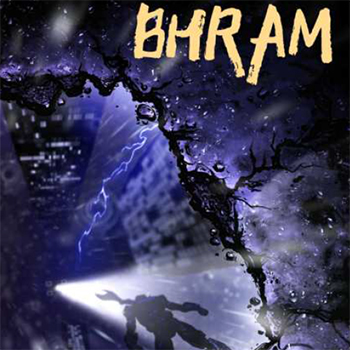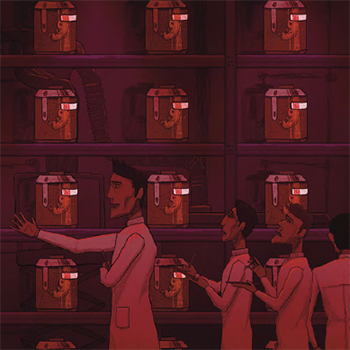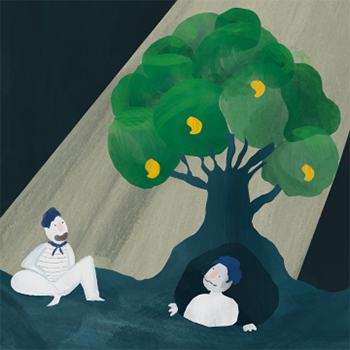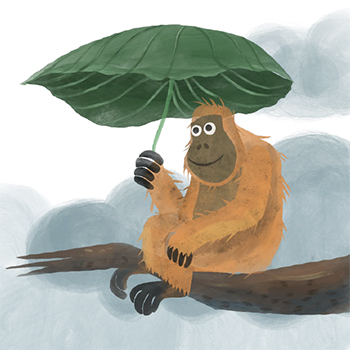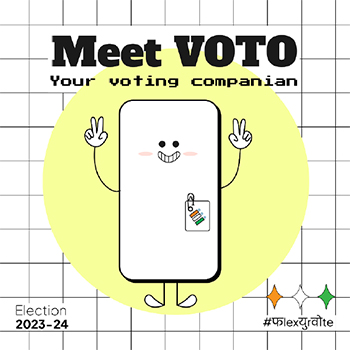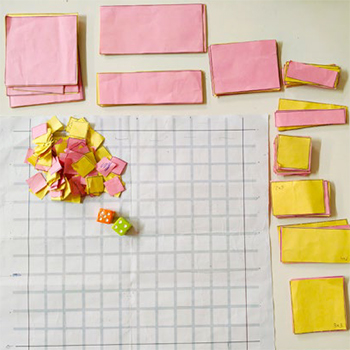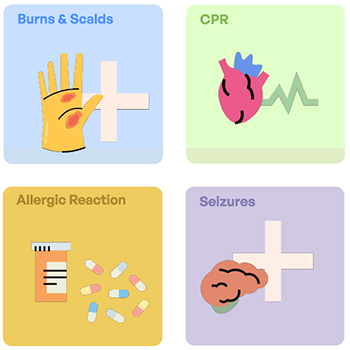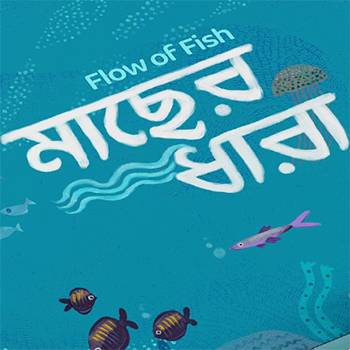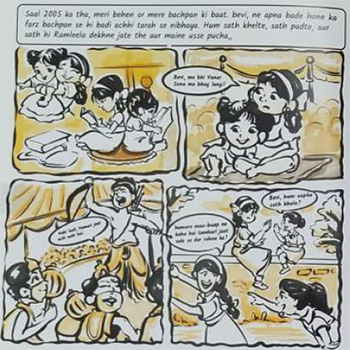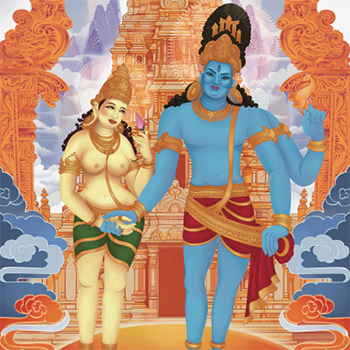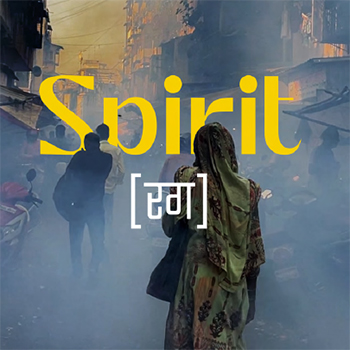M.Des Communication Design 2019-onwards
2021-2023
(44 items)
Govandi arts festival- Projection mapping with Jerry Antony
by Abhijith K S
by Abhijith K S
This report provides an overview of my experience working on the project, including the tasks I was assigned, the challenges I faced, and my learnings. The projected animated film Afsaana is a stunning visual masterpiece that tells the story of the people of the Natwar Parekh Colony (NPC). The film consists of animation created by the children from the colony, such as claymation, paper cutout, live-action conversations, and footage of NPC. The projection mapping technique was used to bring the film to life by projecting it onto a large building wall in the middle of the festival. It was synced to the music, creating a mesmerising, immersive experience for the audience. I was assigned to work under animator Mr. Jerry Antony. Jerry completed his master's in design in animation from NID Ahmedabad two years ago. He previously worked in advertising and is currently a freelance designer. Jerry was one of the resident artists for the event and had already conducted stop-motion animation workshops for the children in Kitaab Mahaal (community library of Natwar Parekh Colony).
Details >>Birds I view- An illustrated field fuide to the Birds of IIT Bombay
by Abhijith K S
by Abhijith K S
“Birds I View” is an illustrated field guide to the birds of the IIT Bombay campus. The book acts as an interactive storybook for an audience new to the field of birdwatching by explaining the birds' characteristics, behaviour, and how to spot them. It also acts as a quick field guide and reference book for birdwatching. I grew up in Kerala and was surrounded by a wide variety of flora and fauna at home. Growing up, I was always fascinated to see new birds and animals and the plants that my mom brought after her evening walks. Even though my childhood consisted of interactions with a lot of varieties of birds seen commonly around Kerala, I never took this seriously and never bothered to observe and learn more about these species. After joining college, my friend introduced me to the world of birdwatching on a weekend walk through the lakeside road. I was still boasting about my childhood and growing up with many of these species. But spotting an Indian paradise flycatcher changed everything. I was mind blown. It was magical. I had seen nothing yet, and a whole new world opened up. After that day, I started looking out for these cute creatures, which teach us a lot through their interactions with nature. I knew nothing about the birds I had seen as a child. More people should know about these fantastic creatures. This project was started on this idea. This is a collection of my experiences and learnings from the IIT Bombay campus.
Details >>Context-based learning materials for English at a foundational level
by Abhijith K S
by Abhijith K S
This project aims to create context-based learning materials to teach English to first- and second-grade students in the Kumaon region of Uttarakhand. The learning materials are designed to be engaging and interactive by introducing the language through activities that encourage inquiry-based learning. Through this project, three activities were created for foundational-level classes using visuals familiar to the students and stories from the region. The activities went through several rounds of testing over four schools in the Nainital district with the help of Siksha Sahayaks. The project is being carried out in collaboration with an NGO called Aarohi in Uttarakhand.
Details >>AR For Institute Events- Use Of AR For Project Display During Exibitions
by Akshata Khare
by Akshata Khare
By employing augmented reality, information such as advertisements, posters, and announcements regarding upcoming events, launches, festivals, and more can be communicated without the need for printing posters, pamphlets, and other physical materials that result in waste generation. Our objective through this project is to propose an alternate solution that employs AR to disseminate information, not only reducing waste but also paving the way for further advancements in the digital space.
Details >>Understanding varied perception on Gender Cell And how to (re)solve them
by Akshata Khare
by Akshata Khare
Any unpleasant or unwelcome behaviour or action that is sexual in nature or connected to the person’s gender and sexual orientation is considered sexual harassment. People who are the targets of sexual harassment experience a hostile atmosphere that affects their ability to learn, find work, and maintain their mental and physical health. IIT Bombay’s Gender Cell investigates sexual harassment complaints through the Internal Complaints Committee and conducts events to spread awareness. It is important that the students/staff/residents of IITB have trust in the organisation and approach when faced with sexual harassment or any sexual discomfort. This project aims to understand the various perceptions, especially among students (focus group), and how we can build the trust so that students can go to the right place run by the trained professionals and get access to resources like counselling and security when needed. It takes a lot of courage to stand up and speak for yourself and, more so, to launch a complaint and have faith in an organisation where you don’t know anyone. Perceptions of people around the victim play a crucial role in deciding what steps the victim takes. By taking interviews and being part of meetings and discussions with IITB gender cell members, I tried to understand the perceptions and how we can (re)solve them. What is the best way to talk about a sensitive topic? How can it be most effective? Do students/staff face sexual harassment on campus? How do they deal with it? Who do they first approach? Do they know about gender cells? Do they know how to approach it? Do they know about the process and the members? Do they trust the organization? If not gender cell, where do they go? Why do culprits do what they do? What happens when the victim gets wrong advice? Is it harmful? These are some of the questions that I tried solving for this project.
Details >>Game design for Inclusivity
by Akshata Khare
by Akshata Khare
There is a noticeable lack of games that allow sighted individuals and people with visual disabilities to play together. When asked, individuals with visual disabilities often struggle to name games that accommodate both groups. It raises the question of why game development tends to focus on creating games exclusively for the sighted or solely for the blind. Perhaps this tendency stems from the belief that catering to the diverse needs of both sighted and visually impaired players simultaneously is complex or requires significant modifications to game mechanics. There may also be a lack of awareness and understanding about how to design inclusive and accessible gameplay experiences that can be enjoyed by everyone. However, it is vital to recognise the importance of inclusivity in game design. By creating games that are accessible and enjoyable for individuals with visual disabilities and sighted individuals, we can foster social interaction, promote empathy, and bridge the gap between different abilities. The objective of this project is to develop a game that is accessible and inclusive for both players with visual disabilities and those without. By considering the needs, preferences, and abilities of both groups throughout the game design process, we can create an engaging and enjoyable experience that transcends barriers and allows for meaningful participation from all players. Through promoting inclusivity and accessibility in game design, we contribute to a more diverse gaming landscape, where individuals with varying abilities can come together, have fun, and share memorable experiences.
Details >>Interactive Short Film for Teaching Moral Education in Schools
by Anubhav Nagpal
by Anubhav Nagpal
This project explores an advanced concept of teaching moral education in schools with the help of meticulously designed interactive short films utilising choice architecture and the Soviet montage theory. The final output of this project is a short film, prototyped online with interactive capabilities for teaching values. The students’ all-round performance in schools is inversely related to the amount of bullying and violence faced in the schools (OECD, PISA 2015 Database), and the introduction of moral education in schools drastically reduces the instances of bullying and violence (MEXT 2007-2012). In this project, research was done on the education systems, moral education curriculum, and teaching methods in schools in several countries to find scope for improvement in the moral education imparted in Indian schools. Analysing their curriculum and upon primary research with current school students, a new curriculum is designed for class VII. Research to understand choice architecture and Soviet montage theory, along with in-depth analysis of several interactive films, was done to understand the medium and its potential. The insights were used to make an interactive short film for imparting moral education.
Details >>Last Light Experimental Short Film- A live action experimental short film inspired from personal experiences
by Anubhav Nagpal
by Anubhav Nagpal
This project is an exploration of the process of weaving narratives by documenting dreams and the craft of communicating the surreal narratives through the medium of audiovisual. In this project, a live-action experimental short film has been produced as the final outcome. The film attempts to communicate various perspectives to a narrative with a layered story and, at the same time, maintain a surreal, dreamlike look to it, which may carry the viewers to an imaginative journey. At its core, the narrative is derived from extremely personal experiences and events from both dreams and reality. It has then been processed to form a compelling and impactful narrative in the form of a film.
Details >>A typographically-led campaign addressing overfishing of endangered marine species
by Dishant Mehlawat
by Dishant Mehlawat
The global seafood industry significantly impacts the world’s oceans and its wildlife, particularly the Atlantic and Pacific bluefin tuna, which have seen a reduction of 80% and 90%, respectively, due to overfishing. The consumption of bluefin tuna, a delicacy in sushi, is particularly prevalent in countries such as Japan, Italy, Spain, and France. Several campaigns have been launched to raise awareness about the dangers of overfishing, including Seafood Watch, Fish 2 Fork, Good Fish Guide, and the Marine Stewardship Council (MSC). These campaigns aim to educate consumers about the importance of responsible seafood consumption and encourage businesses and consumers to make choices that are less harmful to the environment. With this in mind, we propose to create a typography-led campaign for social activism as part of the D&AD New Blood Awards, with the brief given by Google and H_M_C_T. Our campaign will aim to raise awareness about the impact of overfishing on the world’s oceans and wildlife and encourage individuals to make conscious choices about their seafood consumption. Using typography, we will create a powerful visual message that will resonate with consumers and encourage them to act.
Details >>Devanagari body text font for applications with constrains spaces
by Dishant Mehlawat
by Dishant Mehlawat
Packaging is a major sector that uses regional languages in various sizes. Devanagari, being one of the important scripts, is used in small sizes for printing instructions and information on labels. However, the readability in such cases is very low. Out of the available ones specially designed for smaller sizes, the major ones are owned by organisations or not free for commercial use, making brands choose the economical choice of using less readable fonts for the instructions and packaging of the product. The project aims at creating an open-source Devanagari body text font for application in packaging design for sizes smaller than 9 pts (3.175002 mm).
Details >>Experimental Variable Devanagari Display typeface
by Dishant Mehlawat
by Dishant Mehlawat
Indic scripts have a rich history and have been used for centuries in the Indian subcontinent. However, designing typefaces for these scripts presents unique challenges compared to Latin scripts. In recent years, Indian type designers have significantly progressed in developing complete and refined solutions for Indic scripts. With the expansion of digital media and the growing number of audiences, the demand for Indic fonts continues to rise. The digitisation of Indic fonts with Unicode has significantly increased usage across multiple devices for various applications. With the advancements in font technology, a single optimised font can efficiently work in print and digital media. The project investigates the diverse forms and styles of the Devanagari script through the development and experimentation of a variable font. The project utilises innovative variable font technology to create two axes—the weight axis and the decorative axis. Unlike conventional variable fonts that merely alter the width or weight of a typeface, this project takes it a step further by incorporating the decorative axis. The decorative axis adds a new dimension to the font by changing its visual grammar, allowing for more flexible usage across various media and applications.
Details >>The Right Path?- Graphic Novel on underprivileged Artists and their Dreams
by Hemant
by Hemant
The graphic novel tells about the reality of so many underprivileged artists who are all trying to achieve their goals and making efforts to complete their dreams. Taking two stories, for example this graphic The novel includes the struggle, moments, and the journey of an artist passionate about dance and how they are putting effort into making their dreams come true, as well as questions to all those strugglers who left their homes to pursue their dreams if they have chosen the right path. This report describes the design process involved in the creation of the graphic novel.
Details >>Rebuilding a Life and a Community- A Documentary Film on Parveen shaikh and her journey
by Hemant
by Hemant
This Film tells about a person who is a remarkable woman who faced numerous challenges in her life. She lived on a footpath for a long time until the government intervened and rehabilitated her. Despite the difficulties she faced, she never lost her spirit and remained committed to her goal of serving society. She became an inspiration to many, proving that it is possible to turn your life around with the right mindset and support. Through her work, she continues to make a significant impact and inspire others to overcome adversity and work for the betterment of society.
Details >>Arrival of First Printing Press in India
by Jinal Jignesh Shah
by Jinal Jignesh Shah
As a kid, I was very attracted to storytelling, comic books, and illustrations. I still remember the storyline and plot of “Merchant of Venice,” an English prose story written by William Shakespeare and taught to us in school. Stories of Shivaji Maharaj fighting Mughals and the fight of India for independence against the Britishers were my favourite topics in school. When I read books, I was always curious to know what happens next, what the other character is thinking, how the sequence of the story goes, and how come small actions taken by some people decide the fate of many. Many times I tried reimagining some stories from different points of view, and the activity kept me busy for multiple hours. I also enjoyed drawing moustaches and funny expressions on the portraits of famous personalities made in our textbooks.
Details >>Re-designing the NCERT Textbooks
by Jinal Jignesh Shah
by Jinal Jignesh Shah
At the start one might feel that a very small change does not make a huge difference. But as time goes on, the seemingly small change makes a very small difference. And then it slowly leads to bigger differences. And then it slowly leads to bigger differences. The theory of the butterfly effect is what gives us the hope that any small attempt by us will carry the potential to eventually impact society. My final project for the semester is inspired by the current scenario in the education system of the country. And I have utilised this opportunity to bring a small change to this seemingly vast system.
Details >>Teaching How To Develop Anthropomorphic Characters
by Kunal Khawaskar
by Kunal Khawaskar
This project focusses on creating anthropomorphic characters by studying the famous symbols of Indian states, which will later be used to teach how to develop such anthropomorphic characters by converting them into a guidebook that explains the step-by-step process of anthropomorphic character creation to the students who are interested in character and mascot design. The concept of anthropomorphic characters is very popular and widespread in other countries like the USA, Germany, Sweden, Japan, China, etc., where they use the same approach of character design in mascot design not only to represent a brand but also to represent TV shows, events, cities, states, and even countries. Where an anthropomorphised character becomes the face of that subject (an event, brand, city, state, country, etc.), But the culture of mascots is very limited when it comes to India. Most of the iconic mascots that we have seen in India that represent a brand or a service (Bholu the elephant, MoneyKumar mascot for RBI, Amul girl, Chintamani, Maharaja, etc.) are all used for commercial purposes only. There is no such representative character of Indian states that will act as a mascot. This is where my project topic comes in. I will be working on the creation of anthropomorphic characters, which will serve as mascots for the Indian states, which can represent a particular state for which it is most popular for. Also, another benefit of these characters is that they can be used later in a variety of other applications, like in sports events, or Jhaki on 15 August, or to promote tourism in the state, etc.
Details >>Revival of Ganjifa card game
by Kunal Khawaskar
by Kunal Khawaskar
I discovered that the traditional card game of ganjifa was at risk of being forgotten. This realisation inspired me to find a solution to revive this beautiful, hand-painted card game in India. As my project progressed, I decided to focus on creating a design solution that would make Ganjifa gameplay more accessible so that more people can play it. Because the best way to revive a game is to play it. However, one major obstacle with the ganjifa card game was that very few people actually knew how to play it. Fortunately, I was able to connect with Jue Taware, a researcher at INTACH in Pune, who helped me understand the gameplay better. After much consideration, I decided to create a video to help provide games rules for Ganjifa in India.
Details >>Change- A Visual tribute to the Adventures of Vijayan and Mohana
by Lakshmi Chandran
by Lakshmi Chandran
Change is a web graphic novel that captures the essence of what Vijayan has left behind with Mohana. Vijayan and Mohana are a couple of tea shop owners from Kochi, Kerala. Until their late 60s, they travelled the world to around 26 countries. The story attempts to portray the influence their journeys had on them, their family, and also the people around them. The narrative tells the story from Mohana’s point of view to show how the journeys changed her as a person who had never travelled until she met Vijayan.
Details >>There is a Kokaachi in my house
by Lakshmi Chandran
by Lakshmi Chandran
The southern Indian state of Kerala is well known for its vibrant and rich culture, which is rooted in customs, greenery, festivals, legacy, history, architecture, mythology, and legends. The state is home to a wide variety of people, each of whom has their own distinctive customs and practices, adding to the state’s rich cultural legacy. The state is also renowned for its colourful celebrations, such as Onam, which is widely observed throughout the state. Beautiful historical landmarks like the Mattancherry Palace and the Padmanabhapuram Palace, which offer a look into the state’s illustrious past, can be found in Kerala. A number of historic temples, churches, and mosques that display the artistry and ability of the state’s craftspeople are among the state’s remarkable architectural structures. Several fascinating tales that have been passed down through the decades may be found in Kerala, which is also rich in myths and legends. Kerala is a wonderfully unique and intriguing place to visit and explore because of all of these factors. I could go on and on about how rich the culture is.
Details >>Govandi Arts Festival: Merchandise
by Madhuri Chandrasekhar
by Madhuri Chandrasekhar
Govandi Arts Festival as a DES project was a group project; volunteering for the festival was conducted for the artistic awakening of the youngsters and kids of Natwarparekh Compound, Govandi, Chembur, Mumbai. Eight students from IDC, IITB, volunteered for the same. My project was to work under the co-curator of the Govandi Arts Festival, Natasha Sharma. I dealt with the making and in charge of the festival tote bags, badges, certificates, T-shirts, stamps, flags, and mementos. Mostly all these wanted materials were bought and made within 5 km of the happening place at Govandi. The Govandi Arts Festival is a community-based initiative led by the Community Design Agency (CDA), Mumbai. This initiative aims to break the existing negative bias towards this place and people by giving them a platform for their artistic expression: theatre, rapping, photography, filmmaking, and public art, respectively. In this exploratory project I got to work with designing and executing the merch (tote bags, clocks, T-shirts, and flags), along with badges, certificates, layout, and stamps.
Details >>Illustrations for the Novel: The Palace of Illusions
by Madhuri Chandrasekhar
by Madhuri Chandrasekhar
This project is a humble attempt at bringing the visuals of the novel The Palace of Illusions to life through the same perspective the book is written in. This Novel is the Mahabharata told from the perspective of Draupadi. Although the intent was to give visuals to the novel, along the process, the project developed into a standalone set of illustration cards specifically showing what Draupadi, the central woman character of the Mahabharata, felt and went through.
Details >>Churul chronicles
by Madhuri Chandrasekhar
by Madhuri Chandrasekhar
Churul Chronicles is a graphic novel about a girl’s hair and its journey towards self-acceptance. Before curly hair became trendy/pretty enough for the mainstream, most of the curly heads dreaded their hair because of its lack of acceptance for its unruly nature. Stories of their ridicule, unsolicited advice on hair straightening, hacks, and tricks that failed terribly to have society-approved ‘beautiful’ hair came together to weave a story about two individuals: a girl and her hair, where the hair transforms from society-approved ‘beautiful’ hair to unruly, wild, curly hair when she hits puberty, and their journey to make peace with the new change. The visual narrative follows two characters’ worlds, one inside and through the frames, and the other running around and outside the frames. They also coincide, meet, or switch places at certain points as per the demand of the story. This project is an attempt at story writing and visual narrative design in static visual storytelling.
Details >>3090kms: Graphic narrative on a long distance relationship
by Midhun Mohan
by Midhun Mohan
Is there anyone who has not fallen in love? Many who did are fortunate enough to be with their special person. At the same time, many others, including me, have to live our lives counting days until the next time we get to meet each other, since our life decisions have brought about a geographical separation between us. Long-distance romantic relationships pose their own challenges, mostly caused by the various miscommunications that may happen between the individuals as well as other hurdles that they need to fight against and overcome almost on a daily basis to keep their relationship together and strengthen their bond. The narrative here shares the story and experiences of a couple (me and my special person) who have been in a long-distance relationship for over 3 years, ever since they committed to it. The content does not intend to be a guide on how to lead a long-distance relationship or to give tips on the same. What the content intends to do is to create a moment of retrospection for the reader, to think about their own relationship, one in the past or one they are currently going through, and cherish the memories. If the relationship did not work out for them, think for oneself about what went wrong. Even if not these, if the content makes a person who comes across it think about their special someone, it is serving a purpose.
Details >>Reducing desk work fatigue through positive work habits
by Midhun Mohan
by Midhun Mohan
Unhealthy habits at workspaces could lead to a lot of physical and mental exhaustion. Desk work that demands people to sit in one place, working on a desktop or a laptop for a prolonged period, could cause so much strain that it, in turn, affects their productivity. Overexertion at work without giving proper care to one’s health could end up being more counterproductive, even when the intention was otherwise. It is important to take timely breaks at regular intervals, in between work, to relax and refresh the body and mind that has been working continuously to keep you going. This project explores the possibilities of reducing health hazards from fatigue caused by unhealthy habits built specifically around desk work by giving constant nudges and visual cues that would remind people to care for their health as well as suggest how to do the same by providing relevant information on how to act upon and avoid them.
Details >>Wildlife conservation awareness illustrated book
by Mohak Gulati
by Mohak Gulati
This project is a documentation of an illustrated book of poems on endangered animals, traversing the theme of wildlife conservation. The book is an anthology documenting the story of 10 threatened species indigenous to India. Each book spread captures a distinct species whose story is depicted in a short poem and an illustration of the creature. The narrative thread charted across the book is human encroachment. Human involvement, direct or indirect, is consistently the leading factor in ecological disruptions. In writing, I leverage a tone of macabre humour to depict the grim reality of the state of each species. The concluding poem depicts humans themselves as one of the animals that face extinction, thus rounding out the narrative, which starts with human interference and ends with our demise. This project is motivated by my drive towards wildlife conservation. I wish to serve the cause as best as possible with my skill set while still pushing myself to learn new things.
Details >>AXB 1344 Plummeting Down The Tabletop
by Nidhin Joseph
by Nidhin Joseph
Accidents that take place in the world of modern aviation are among the most catastrophic of all possible occurrences in the case of various transportational accidents. These mishaps not only result in the death of people and the destruction of property, but they also have far-reaching repercussions for families, communities, and even entire industries. In light of the significance of aviation to both the global economy and our way of fast-paced life, it is of the utmost importance that these accidents be investigated in great detail in order to ascertain the underlying reason for them and to prevent future incidents of a similar nature. The crash of Air India 1344, the flight plummeting down the Calicut airport’s tabletop runway on August 7, 2020, was a terrible event that sent shock waves through the aviation industry. This graphic-illustrated book tries to explain, from a human factors point of view, storytelling, that glance through the chain of events that led to this terrible accident. With the help of pictures and easy-to-understand language, readers can learn more about the contributory factors that led to this tragic accident. This book initiates discussions on the human factors and socio-technical aspects behind the contributory factors that led to the accident. This book thereby becomes an essential read for the people linked to the aviation industry; at the same time, it is curated to also cater to the general public who are curious to know more about the accident dynamics behind the incident.
Details >>Peculiar World of Charles Bonnet syndrome- A 360 VR Immersive Film based on rare medical condition of CBS
by Nidhin Joseph
by Nidhin Joseph
“PECULIAR WORLD OF CHARLES BONNET SYNDROME” is a ground breaking 360-degree VR film that provides an immersive journey into the mind of a 70-year-old person suffering from Charles Bonnet Syndrome (CBS). Utilising cutting-edge technology like Twinmotion 2022 and Da Vinci Studio, the project crafts a narrative-driven experience guided by retrospective voice-over. It recounts the detailed hallucinations and how they affect the subject’s mental health, creating a bridge of understanding and empathy between the viewer and the condition. The film represents an evolution from an initial concept of an AI-generated graphic novel to a more powerful and impactful VR experience. It aims to enlighten families of CBS patients and the broader audience about this rare medical condition, providing insights that transcend clinical explanations. Its innovative approach sets new benchmarks in medical education, combining technological prowess with artistic storytelling. The project demonstrates the potential of VR in fostering human connections and empathy, opening doors for future explorations in healthcare, technology, and education.
Details >>AXB 1344 : Virtual Reality Training Experience for Aviation Accident Investigators: Featuring Case Study on Air India 1344 Accident, 2020 Calicut
by Nidhin Joseph
by Nidhin Joseph
An innovative approach aimed towards aviation accident investigation training through the development of a Virtual Reality (VR) training module. This project specifically focusses on the Air India 1344 aircraft accident that occurred in Calicut in 2020, recreating the incident in a VR environment to enhance learning and understanding of accident dynamics. The primary objective of this project is to leverage the immersive and interactive capabilities of VR technology to simulate real-world accident scenarios of the Calicut tabletop runway crash and plummeting down the tabletop of Air India 1344.To curate and create an impactful training module for aviation accident investigators. By doing so, the project seeks to offer a comprehensive, experiential training solution that goes beyond traditional learning methods. The VR module encompasses several key features, with overarching chapters with a narrative structure in the form of three virtual reality doorway journeys: Investigate AXB 1344, Explore AXB 1344, and Understand AXB 1344. This experience includes a realistic 3D environment replicating the accident site, interactive investigation procedures, and immediate feedback mechanisms and an interactive graphic novel unveiling that can deepen the understanding of the user about the events that led to the accident. The training module is designed to improve the problem-solving skills of aviation professionals, enhance their decision-making abilities under stress, and better prepare them for real-world accident investigations with a better understanding of human factors and sociotechnical system factors linked to the Air India 1344 accident.
Details >>Govandi Arts Festival- Crafts and Skills Mapping with Meera Goradia
by Reshma Issac
by Reshma Issac
Natwar Parekh Compound (henceforth referred to as NPC) is home to over 10,000 people residing in 53 buildings. It hosts a diverse population of people rehabilitated from all over Mumbai and is among the most marginalised in the city. These people are involved in various vocations for their daily bread. It comes as little surprise then that NPC is also home to people with varied skill sets and those who have mastered unique crafts. While a majority of people are involved in basic, easy-to-learn but in-demand skills such as sewing, a craft mapping of the area (carried out by Shireen and Shahista, volunteers from the community) reveals a number of people who have developed and are masters at rare skills and crafts. An emerging pattern across the skills within the community is that it is very evidently subject to the circumstances of the smaller cultural and social subgroups within the larger network that makes up the community. For instance, almost all of the women who are mehendi artists are Muslim. Or that most people involved in sewing or beadwork are women.
Details >>THISPLACE- A narrative on the forced displacement of an indigenous community
by Reshma Issac
by Reshma Issac
Forced Displacement or Forced Migration is an involuntary or coerced movement of a person or people away from their home or home region. But the UNHCR (United Nations High Commissioner for Refugees) puts it more accurately as (people or communities) displaced as a result of persecution, conflict, generalised violence, or human rights violations. Forced displacement is not a concept that is alien to the Adivasis, the indigenous communities of India. In fact, having to deal with land alienation, being outcasted—treated as literal aliens in rehabilitated land, loss of access to and control over forests—is still very prevalent in our country to this day. One of the major causes of enforced migration is development and resource extraction projects. These vulnerable adivasi populations who have lived in the forests are traditionally dependent on forest resources for their subsistence, and displacement impacts their life and health and, most importantly, uproots their identities, much like the trees of their forests are in the case of many of these development projects.
Details >>Crumbling Mountains, Mighty Women- A tale of sisterhood from the sinking city of Joshimath
by Reshma Issac
by Reshma Issac
Crumbling Mountains, Mighty Women - A Tale of Sisterhood from the Sinking City of Joshimath—is a 15-minute documentary film that tries to capture the human story of the native pahadi women of Joshimath who are facing eviction from their homes due to the threat to their lives imposed by the unstable lands of which they are inhabitants. While a lot of the sinking of Joshimath is attributed to it being located on a seismically active zone, it is said to have been further accelerated in recent years due to unchecked, extractive human activities in the region, such as tunnel boring for mega power projects. The brunt of this is borne, as per usual, by the most marginalised of people in the region, the indigenous pahadis. The documentary is an attempt at making the mainstream discourse revolving around the topics of extractivism, climate change, etc., inclusive of the people directly affected (and how it affects them exponentially more than those who stand to gain from extractive activities).
Details >>Concerns of Sign Design
by Sanskruti Landage
by Sanskruti Landage
The design of a graphical sign involves its creation by the designer followed by testing for its interpretability using established testing methods.But the results of these tests can be misleading due to inexplicable factors like cultural knowledge, immediate environment, and ability to process information at the user’s end, and thus they can demonstrate agreement even for ambiguous signs. This points out another problem in the test results: they do not guarantee the quality of the sign. Signs that aim to become international standards, especially, should achieve maximum possible clarity in their message and quality in their design. which is also why it’s important to ensure that the sign submitted for testing represents the designer’s finest work. This study further investigates the designer’s process of creating a sign and presents a method to achieve a reasonable level of confidence in the designer of its comprehensibility. Then, additional testing of such a sign will be necessary to verify the designer’s prediction.
Details >>Mapping Mumbai
by Sanskruti Landage
by Sanskruti Landage
Urban planning is a complicated, comprehensive process that necessitates a thorough grasp of a space’s ecology, history, and cultural importance. The precise integration of these factors is required to define not just a region’s physical environment but also its cultural fabric. Nestled upon Malabar Hill, the Banganga tank stands as a testament to the intricate interplay between nature’s embrace and the enduring legacy of human heritage. A symbol of historical significance predating the city itself, this venerable landmark whispers tales of a bygone era. The serene surroundings of this hallowed sanctuary, however, are on the verge of extinction as irrational concrete surges out, indifferent to the delicate web constructed within the ecology. A link, an unseen tie, exists under the surface between the reclamation effort and the natural spring that gives life to this holy ground. A delicate equilibrium teeters on the brink of collapse as waters pour down the shore, replenishing the Banganga tank. The natural spring’s voice may soon be muffled, as its flow is obstructed by the continuous march of reclamation. The state must recognise and value this delicate balance between a location’s physical and cultural traits, and it must take an integrated approach towards urban development. A long-term and deliberate approach may preserve a place’s past while addressing the needs of a rising population, assuring a brighter future for everybody.
Details >>Graphic Novel: Plight of Kids Raised by Single Parents
by Shreyas Vernekar
by Shreyas Vernekar
Through this project, I intend to narrate the life experience of an individual brought up by a single parent. I aim to touch upon the issues faced, psychological coping mechanisms, and changes in mannerisms. Establish an emotional connection towards the single-parent child life and sensitise the readers towards single-parent children missing out on particular niches of skills generally learnt by observing parental figures in their life. The outcome of this project is a graphic novel with black-and-white, detailed, and stylised illustrations with selective colour pages. This book is divided into three chapters, each dealing with different issues faced in childhood, the teenage years, and the adulthood of a single-parent child's life. As the book focuses on single-parent children with an absent parent, I've decided to use a black-and-white colour palette reflecting the "present" and "absent" reality of the protagonist's parent.
Details >>An Unusual Guardian- Interactive Storytelling through Digital Game Design
by Shreyas Vernekar
by Shreyas Vernekar
“While walking down the road the other day, I heard a thumping noise and a rattling of ghoongroos. Instantly, I knew he was patrolling his village, and I dared not cross his path,” the person recounted. “He’s 10 feet tall and would squish anyone walking on his route with his long legs.” Another individual shared a contrasting experience: “He helped me reach home. I thought he was someone from the village.” They described a recent incident: “The other day, I was extremely drunk and passed out. I remember someone lifting me and dropping me at my house.” Rakhandar, the mythical protective spirit of the area, demonstrates a fascinating duality in its identity. It can be mischievous, unforgiving, or fiercely protective towards the region’s residents. This multi-faceted nature adds depth and intrigue to the legends surrounding Rakhandar, making it an enigmatic figure in local folklore. This project aims to bring the rich folklore and mythology of the Konkan region to a broader audience, focussing on the fascinating and enigmatic figure known by various names such as Rakhan dar, Rakhnau, Naas, Rakhno, Devchar, Daivata, and more. These names represent a consistent spirit god believed to patrol villages, protect their inhabitants, and assist those in need. The project seeks to create an interactive and immersive environment that transports users to rural Konkan, with abundant coconut trees, shimmering springs, and numerous Rakhandar shrines. By sharing these local stories on a broader platform, the project aims to preserve and celebrate the cultural heritage of the Konkan region while fostering a deeper understanding and appreciation of its mythology and traditions.
Details >>Instructional design for 10th Graders on 3D drawing with a focus on One Point Perspective
by Stuti swamiwal
by Stuti swamiwal
This project aimed to ignite children's curiosity and boost their confidence in art, especially in an area like 3D object rendering. Perspective drawing is a tricky subject for newcomers, particularly those between ages 13 and above, since they just begin to learn complex problems that require spatial visualisation at that stage of their educational journey. This project addressed this by making the perspective drawing instruction and learning more engaging, interesting, interactive, and easy to be taught in a school setup.
Details >>Learning Independence
by Swati Yadav
by Swati Yadav
This project is a proposal for introducing same-language karaoke-based subtitles for all the videos within YouTube to facilitate effective and engaging reading activity for the viewers. The objective for this project is to alleviate the English learning experiences, build confidence, and create positive change by improving English literacy skills in Indian citizens and cultivating a culture of lifelong learning. This project helps build conducive learning for everyone irrespective of their exposure and access to printed reading materials. Post re-affirming the problem space by doing a pilot interview with four adults and several ideations for sustainable solutions, this project is situated to use the findings from Brij Kothari’s research on Same Language Subtitling as a jump start and explore the kind of interventions that can be deployed. A literature review is done as part of secondary research that introduces the topic and situates this project. Qualitative research is done to understand how Indian users, specifically women, face challenges while learning the language and whether the proposed design interventions will lead to desired outcomes. The report includes a summary of the ideas generated and the iterative process to create the layouts with feedback from different stakeholders. And it is concluded with feedback from the learners and experts on the prototype along with future steps for evaluation and web integrations.
Details >>Society on a Scroll: A reflection on the mindsets of young individuals and their complex relationship with Social Media
by Swati Yadav
by Swati Yadav
This project explores the complex relationships individuals have with their screens in the age of the internet and social media. AI and machine learning techniques are used to curate personalised content for users, resulting in varied effects of mindless browsing on different individuals. Through interviews with 20 individuals of diverse age, profession, and demographics, 8 unique personas were identified. Their stories were then transformed into illustrations that depict the emotions and relationships they have with social media. The project utilises conversations and a satirical visual approach to portray the chaotic emotions they experience on a daily basis. The project's findings shed light on the negative impacts of social media on individuals, including feelings of isolation, anxiety, and addiction. The illustrations created for this project aim to capture those implications and concerns in a humorous and thought-provoking manner. The project also captures behavioural insights from their social media usage patterns that may be helpful in exploring digital wellbeing strategies to help people address problematic digital behaviours, manage distractions, and improve their autonomy around how they spend their time.
Details >>Devanagari Display Font
by Vedang Pathre
by Vedang Pathre
An imbalance can be seen in the availability of fonts for the Devanagari script as compared to the Latin script. The disparity increases when we narrow this down to display fonts. It is essential to create newer fonts specifically for the Indian context so that the script can win the graphic design community and meet the demand for creative type design applications in a native script. We can observe a gap in the typefaces used by newspapers for their headlines, where a space-efficient font can help with the layout and other needs of publication houses, as pointed out by Prof. G. V. Sreekumar. This project aims to create an open-source Devanagari display typeface for the primary application in newspaper headlines.
Details >>Shore- Spreading Awareness using Location Based AR
by Vedang Pathre
by Vedang Pathre
Amidst the vast expanse of our oceans, where mysterious depths await exploration, there exists a realm of wonder hidden within our reach—the enigmatic shores. These coastal realms, brimming with life, offer a gateway to the extraordinary. Yet, in the urban tapestry of Mumbai, we often overlook their allure, blind to the treasures they hold. Such is the grandeur of our coastal ecosystems that goes unrecognised, and this effort seeks to put light on this exquisite domain. Shore is a location-based AR app that aims to increase awareness of coastal biodiversity while also luring individuals to see these lifeforms for themselves. The app presents users with a thrilling journey of exploration, with narratives and assistance, by fusing the digital and physical worlds. This initiative not only showcases Ar's potential as a digital activism tool, but it also emphasises the need for increased awareness and action to conserve our fragile marine ecosystems.
Details >>Animal depiction in Indian Art throughout history: Cattle (Cows, Oxen and Buffalos)
by Yash Vardhan Singh
by Yash Vardhan Singh
This report examines the depiction of cattle in Indian art over various periods, from the Indus Valley civilisation to the colonial era. The portrayal of cattle in Indian art is an important aspect of the country’s cultural heritage, as cows have been a symbol of wealth, fertility, and agricultural abundance in Indian society for centuries. The report delves into the different styles and techniques used to represent cattle in art during different time periods, such as the stylised and geometric depictions in the Indus Valley civilisation and the more realistic and detailed representations in Mughal art. It also discusses the religious and social significance of cattle in Indian society and how this is reflected in their portrayal in art. Finally, the report examines how the depiction of cattle changed during the colonial era, as Western influences began to shape Indian art. Overall, this report provides a comprehensive overview of the representation of cattle in Indian art and its evolution over time, offering valuable insights into the cultural and historical significance of these depictions.
Details >>City For All: Living together with animals
by Yash Vardhan Singh
by Yash Vardhan Singh
The project explores the relationships between stray animals, people, and their spaces. Through storytelling, we spread awareness about caring for street animals and showcase the beauty of animal-human coexistence in cities. This children’s book features three captivating stories, blending photographs and illustrations to engage young readers. The first story captures the bond between humans and community animals, highlighting the joy of harmonious living. The second tale emphasises the importance of compassionately caring for injured animals, inspiring children to handle and interact with them with kindness. Lastly, the power of adoption takes centre stage, showcasing the transformative journey of a stray finding a loving home. As strays become part of our communities, it is essential, especially for children, to learn how to coexist with them. Join us on this captivating journey where photographs and illustrations weave stories promoting empathy, kindness, and the well-being of street animals. Together, let’s create a world where every animal is cherished and cared for.
Details >>The Awadhi Delight: Visual Representation of Cuisine of Awadh
by Yash Vardhan Singh
by Yash Vardhan Singh
This report delves into the fascinating world of Awadhi cuisine, unravelling its rich history, cultural significance, and unique flavors. The project aimed to generate interest and appreciation for Awadhi cuisine by presenting it through various mediums, including animations, visuals, and storytelling. By exploring iconic dishes such as Dumpakht, Dum Biryani, Nihari, and Tundey Kabab, the project aimed to showcase the culinary heritage of Awadh. Overall, this project serves as a testament to the vibrancy and allure of Awadhi cuisine. By capturing its essence through visual mediums and storytelling, it endeavours to preserve and promote the culinary heritage of Awadh for future generations to cherish and explore.
Details >>KALA Cast- An audio podcast of talents among us
by Stuti swamiwal
by Stuti swamiwal
Every second person is, in today's time, in some way or the other, connected with creativity, but what sets all of us apart are our unique stories. Whether you're an art lover or simply curious about the people behind what they do, "Kalacast" offers something for everyone. It is a celebration of diverse and multi-talented artists who exist among us or can be found hustling, creating, and passionately working around us. Every episode takes a deep dive into these creative individuals' personal paths and hard work, delving into their artistic journeys, inspirations, drive, and experiences that are moulding them into becoming even more accomplished and distinctive humans of tomorrow. Kala means ART, and we cast artists in this podcast. For this project series, Kala Cast, which focuses on musicians who come from totally different backgrounds, provides the introduction to diverse artists whose stories should be heard.
Details >>2022-2024
(29 items)
Mayel Lyang- A game inspired by Lepcha folklore
by Aaron Chen Lepcha
by Aaron Chen Lepcha
The Lepchas are the indigenous people of Sikkim, whose population has gradually diminished over the years, leading to the erosion of their rich tribal culture in the face of modernization. This project aims to educate and introduce people to the unique heritage of the Lepchas through a narrative-driven game. Instead of relying on textual or motion-based storytelling, the project employs an interactive experience to ensure greater engagement and better retention of information. Through the game’s narrative, players are introduced to the everyday lifestyle, traditions, and cultural practices of the Lepcha community while exploring the environment. The project seeks to raise awareness about the Lepcha tribe and contribute to preserving and promoting their cultural identity.
Details >>Enchanting Tales- Kerala Folklore Unveiled through Parallax Scrolling Comics
by Abhinav S
by Abhinav S
The search for the perfect story for this project draws inspiration from Aithihyamala, a remarkable compilation of Kerala’s timeless folklore by Kottarathil Sankunny. This collection brings together captivating tales and legends that reflect the rich cultural heritage and storytelling traditions of Kerala. Alongside literary exploration, oral accounts and local legends shared by elders and community members provided helpful information regarding the region’s diverse folklore. Among these, the story of Poothapattu emerged as a particularly compelling narrative. Blending elements of love, adventure, and the supernatural, Poothapattu stands as a significant piece of Kerala’s cultural legacy. Its depth and emotional resonance make it an ideal choice for reinterpretation through the parallax scrolling comic format, celebrating both tradition and creativity.
Details >>Kuttichathan- A choose your own adventure comic
by Abhinav S
by Abhinav S
The search for the perfect story for this project draws inspiration from Aithihyamala, a remarkable compilation of Kerala’s timeless folklore by Kottarathil Sankunny. This collection brings together captivating tales and legends that reflect the rich cultural heritage and storytelling traditions of Kerala. Alongside literary exploration, oral accounts and local legends shared by elders and community members provided helpful information regarding the region’s diverse folklore. Among these, the story of Poothapattu emerged as a particularly compelling narrative. Blending elements of love, adventure, and the supernatural, Poothapattu stands as a significant piece of Kerala’s cultural legacy. Its depth and emotional resonance make it an ideal choice for reinterpretation through the parallax scrolling comic format, celebrating both tradition and creativity.
Details >>Cancer disease management system- Simplifying the chemotherapy journey
by Abhishek Yadav
by Abhishek Yadav
The project was formed by discovering the challenges patients and their caregivers encountered during chemotherapy. Insights gathered from the participants during interviews helped provide a foundation around the problem, further guiding the solution. The approach during the project included brainstorming ideas, generating scripts with different stories, developing visuals, and crafting a video solution. The content was tested during the process and revised based on the feedback. Real-life stories narrated during the interviews were integrated, and elements of hope were added along with the data. The outcome of an explainer-illustrated video simplifies the journey. It reduces confusion by providing essential information along with common myths and misconceptions woven together with the patient's story to give them hope, making it an understandable resource, easy to locate, and with information straightforward to digest in narrative format.
Details >>Health Shield
by Abhishek Yadav
by Abhishek Yadav
Health Shield seeks to dispel common myths & misconceptions about health insurance and empowers Indian consumers with easily understandable information by addressing regular problems. The project's output includes an explanation video and a collection of icons designed to help customers understand and navigate the insurance process. These icons in the explainer improve the entire process—from the foremost explanation to the last payment stage—by increasing recall value and creating a unique style through their consistent visual design. User feedback and iterative revisions provided the final video helped user preferences and requirements, building a more appealing, consistent, approachable, and explanatory tool. For Indian users, Health Shield effectively demystifies the health insurance procedure, making it better, i.e., more accessible and understandable.
Details >>The D Phase- A Graphic Novel Chronicling my Personal Journey through Depression
by Akashnath M
by Akashnath M
“The D Phase” is a graphic novel that explores the emotional landscape of depression through a deeply introspective narrative. Rather than presenting a conventional account of mental illness and intervention, the story follows the journey of Adhi, a once-vibrant college student whose life is upended by a sudden change in environment. Struggling with grief, isolation, and fading connections, Adhi’s experiences reflect the complexities of living with depression. The narrative vividly portrays his daily battles with insomnia, lethargy, and emotional detachment, while also tracing his gradual progression through the five stages of grief. Through expressive visuals and evocative storytelling, “The D Phase” offers a compelling portrayal of mental health, resilience, and the path toward acceptance and recovery.
Details >>The Malabar Hookah
by Akashnath M
by Akashnath M
This design project aims to narrate the captivating story of the hookah makers of Malabar through the engaging medium of motion graphics. It highlights the lesser-known fact that the iconic brass hookahs, often associated with Arab culture, were crafted in the coastal regions of Malabar, Kerala. The project explores the history of the Malabar hookah, from its origins and manufacturing beginnings in Kerala to its growth and eventual decline. It examines the cultural significance of the hookah and its symbolic connection to both local and Arab lifestyles. Additionally, the project addresses the decline of this craft, analyzing economic, social, and global factors contributing to its near extinction. It provides insights into the current state of the Malabar hookah, the challenges faced by remaining artisans, and efforts to revive this traditional craft.
Details >>Just One Dress- A short film unleashing Life Stories
by Anisha Verma
by Anisha Verma
The "Just One Dress" project is a live-action short film inspired by a real-life experience of a friend. Her story became the foundation, evolving through ten iterations to shape the desired narrative. After rough storyboarding and auditions, the chosen protagonist had to cancel at the last minute. Faced with a challenge, I stepped in as the protagonist since others were occupied with their own projects. Throughout production, I directed all scenes, grateful for the support of friends and juniors who made the movie a reality. The report covers the ideas generated and the iterative journey from screenplay to post-production and concludes with feedback from learners and personal insights gained during the process.
Details >>Mind your steps @IDC- Exploring how individuals discover methods to communicate and make relationships
by Anisha Verma
by Anisha Verma
The culmination of this research is an illustrated artifact, created using a blend of digital and traditional watercolors. These illustrations are designed to be both humorous and thought-provoking, depicting the various gestures and methods individuals adopt to improve communication. By employing satire, this project not only critiques the current communication practices but also aims to inspire self-reflection and encourage a more engaged and connected community at IDC. This project underscores the opportunity to redefine IDC's culture. Embracing new communication styles can lead to greater engagement and stronger relationships, fostering a sense of belonging and support for all members of the IDC community. Through this creative exploration, the project aims to set new standards for communication and interaction, paving the way for a more vibrant and interconnected future at IDC.
Details >>Creating Financial Literacy to Empower Indian Youth- A core life skill in 2023
by Aparajita Prasad
by Aparajita Prasad
Despite global efforts to enhance financial literacy, India struggles due to interstate disparities and a lack of formal training and awareness. With only 27% of its adult population being financially literate, the country faces significant challenges, especially given its low overall literacy rates and a large population outside the formal financial system. To tackle this, the project targets young adults aged 18-26, a demographic that includes college students and soon-to-enter-workforce bachelors. Recognizing their preference for brief and engaging content, the initiative utilizes animated reel videos as the primary educational tool. These videos, tailored for distribution on social media platforms such as Instagram, LinkedIn, and Twitter, aim to pique interest in financial literacy. By serving as an introduction to more comprehensive resources, the project seeks to spark wider discussions among youth, thereby enhancing their understanding and accessibility to financial literacy.
Details >> Designing The Look of The Games for Ahmedabad 2036
by Aparajita Prasad
by Aparajita Prasad
This project aims to create a compelling visual identity for the 2036 Olympics, potentially to be hosted in Ahmedabad, India. The “Look of the Games” is a pivotal aspect of any Olympic event, serving as a unifying thread that weaves together athletes, spectators, and viewers from around the world. It offers an extraordinary platform to celebrate India’s cultural richness and modern dynamism, crafting a visual narrative that resonates on a global stage. By blending Indian elements with contemporary design, the visual identity will capture the essence of India’s diverse heritage and vibrant present. This cohesive visual identity aims to showcase Ahmedabad’s unique character, highlighting its journey from a storied past to a promising future. The project underscores the significance of a strong visual identity in enhancing India’s global presence in sports, fostering national pride, and promoting unity. By encapsulating the spirit of the games and the host city, this visual identity will create a memorable and impactful representation of India’s culture and contemporary spirit, leaving a lasting impression on the global audience.
Details >>The ordinary and the Extra Ordinary- AR-Based Graphic Novel
by Banasmita Das
by Banasmita Das
Augmented reality (AR) is a technology that overlays a computer-generated image onto what a user sees in the actual world, forming a combined view. AR holds the promise of transforming the art of storytelling through the creation of immersive and interactive experiences in the real world. Incorporating AR for storytelling opens new avenues of creative expression, providing an immersive and interactive narrative experience. This exploratory project aims to create a storytelling experience with marker-based Augmented Reality (AR). The narrative initially follows a young boy's playful escapades, anticipating the consequences of his academic struggles as he delays returning home. In the AR adaptation, the story transforms, offering insight into the boy's altered perspective. The project goal is to leverage AR to unveil a distinct version of the story, clarifying the original narrative. The scope of this project includes exploring various methods such as motion and sound design, as well as portal effects, to enhance the storytelling experience.
Details >>Legibility-The guidelines of type- An explainer video
by Banasmita Das
by Banasmita Das
This report delves into the fundamental importance of typographic guidelines in design and focuses specifically on the aspect of legibility within typography. Legibility refers to the ease with which individual characters can be distinguished within a typeface. This aspect is crucial for readability, especially for long multiple sentences. Understanding this fundamental guideline is paramount for young design students as they lay the groundwork for effective visual communication. Prioritizing legibility ensures better user experience and accessibility, contributing to the overall effectiveness of design communication. The objective of this project is to emphasize the significance of legibility in design education and to make learning about these principles engaging and enjoyable. While initially aiming to produce a series of instructional videos covering various typographic guidelines, the project's scope was refined to focus on creating a single video due to time constraints. Through scriptwriting, storyboarding, voiceover recording, and video production, the project culminated in an informative motion graphic explainer video on typographic legibility.
Details >>Treads of Toil
by Biswajit Das
by Biswajit Das
“Threads of Toil” is a compelling narrative that delves deep into the human spirit, revealing its unyielding resilience in the face of adversity. At its core, the story showcases the remarkable strength that can be found within individuals when they are driven by shared dreams and the unwavering pursuit of a better life. This project is a testament to the enduring power of hope, resilience, and the human spirit. It reminds us that no matter where we come from or what challenges we face, our dreams and our capacity for friendship can illuminate even the darkest of paths. It underscores the idea that the threads of our shared humanity are unbreakable, weaving a tapestry that connects us all in our pursuit of a better life.
Details >>Impact of Indian Government Welfare Schemes on Handloom Weavers
by Biswajit Das
by Biswajit Das
Handloom weaving, a vital part of India’s cultural and economic heritage, supports millions of artisans across the country. This study focuses on the weavers of Yeola, Maharashtra—renowned for their Paithani sarees—to examine the impact of government welfare schemes on their livelihoods. Through a cross-sectional descriptive approach involving 106 weavers, the research found that while many benefited from initiatives like the Yarn Supply Scheme, Integrated Handlooms Development Scheme, Marketing & Export Promotion Scheme, Health Insurance Scheme, and Mahatma Gandhi Bunkar Bima Yojana, nearly one-fourth remained unaware of these programs. The findings highlight that, despite positive outcomes for informed weavers, bureaucratic hurdles and limited outreach continue to impede progress. The study emphasizes the need for greater awareness, simplified procedures, and stronger implementation to ensure the sustainable upliftment of Yeola’s weaving community and preservation of India’s handloom tradition.
Details >>Kasheer- A motion comic on the plight of kashmiris
by Himanshu Bagati
by Himanshu Bagati
This project explores the aftereffects of Kashmiris post exodus. Through strong visuals and a compelling story arc that follows a Kashmiri pandit kid trying to find out more about his homeland. And on the other hand, he makes a friend who's a Kashmiri Muslim, and he tries to explain his new friend's situation to his family to ease the conflict and invoke empathy. And even though the conflict isn't resolved within, the bond of Kashmiriyat flourishes again at the end. The whole story underscores the power of empathy and friendship in bridging divides and fostering understanding between people scarred by their history.
Details >>Bhram- Form comic origins to action figure
by Himanshu Bagati
by Himanshu Bagati
The project comprises two components: an origin comic and an action figure. The comic's narrative delves into prevalent anxieties surrounding AI uprising, reshaping the conventional hero's journey with a moral compass attuned to contemporary concerns. Ending with a tantalizing cliffhanger, it invites users to delve deeper into the story through interaction with the action figure. Users can manipulate the figure, capture photographs, animate scenes, or simply envisage new adventures. Ultimately, this project endeavors to foster an immersive and participatory user experience, encouraging creativity and exploration within its narrative universe.
Details >>The Invisible People of Manipur- Stories of the Zo Descendants
by Joy Zenhinsang
by Joy Zenhinsang
“The Invisible People of Manipur: Stories of the Zo Descendants” explores the experiences of the Zo tribal community following ethnic clashes in Manipur. Through in-depth interviews with five individuals directly impacted, the book sheds light on the human cost of conflict, highlighting themes of identity, displacement, and resilience. The report details the book’s creation process, emphasizing the use of sensitive in-person interviews to capture the interviewees’ experiences. It acknowledges the challenges associated with this methodology, including dealing with trauma and limited access to comprehensive information. The book’s structure is outlined, showcasing its exploration of diverse perspectives and its aim to raise awareness about the plight of the Zo community.
Details >>Hey Whats that smell?
by Joy Zenhinsang
by Joy Zenhinsang
Northeast Indian cuisine, though rich in diversity and cultural depth, remains one of the least documented regional food traditions in India. This project emerged from the recognition of the limited resources and public awareness surrounding it. Initially conceptualized as an exploration of the region’s culinary heritage, the focus was later refined to a specific state or aspect of Northeast Indian food to allow for deeper study. An initial survey conducted among individuals unfamiliar with the cuisine revealed significant gaps in understanding and perception, including instances of bias and stereotyping related to food habits. This observation reflects broader issues of cultural misunderstanding and discrimination faced by the North-eastern community in other parts of India.
Details >>Concept art book design for Brave New World by Aldous Huxley
by Harsh Karani
by Harsh Karani
This project is an attempt to understand the challenges that are faced in visualizing a world based on a piece of text and generating concept art for the same. The text chosen here is a sci-fi novel, ‘Brave New World,’ by Aldous Huxley. The aim of the project is to create concept art for an animated movie/series that aims to capture the essence of ‘Brave New World’ with a thorough reading and understanding of the text and sticking to the source text as written by Aldous Huxley in 1932.
Details >>The Search for the Extra(Ordinary)- Imagining the Food of the Future
by Muskan Bagaria
by Muskan Bagaria
This project explores the concept of the ‘Spirit of Mumbai’, capturing the city’s complexities and contradictions through an experimental short documentary film. It seeks to portray the essence of Mumbai using sound and visuals, moving beyond traditional narrative structures and dialogue-based storytelling. The focus lies in mastering non-verbal forms of expression to create an immersive and thought-provoking experience. By experimenting with the audio-visual medium, the project investigates the nuances of abstract storytelling and aims to evoke the dynamic rhythm and multifaceted spirit of the city.
Details >>Storytelling for children with dyslexia
by Muskan Bagaria
by Muskan Bagaria
The Search for the (Extra)Ordinary is a fictional children’s book that presents a vivid and imaginative portrayal of the future of food and dining. In this world, food is no longer just food, and restaurants are no longer merely places to eat. Instead, they have evolved into art forms and experiences, influenced by innovation and technology. At the same time, the book illustrates the seriousness and potential trends of future food. The project focuses on exploring creative possibilities rather than predicting actual future trends. It aims to be an engaging and thought-provoking visual presentation, inviting audiences to contemplate the fascinating prospects of the 'Food of the Future.'
Details >>Engaging First Time Voters How to make an informed voting choice ?
by Pallavi Soni
by Pallavi Soni
Dyslexia is a learning disability that affects individuals with average or above-average IQs, presenting challenges in reading and decoding words. This project aims to engage dyslexic children in reading and understanding stories & poems. Often, dyslexic children struggle to comprehend the meaning of texts they read. My goal is to help these children connect words (text), sounds (pronunciation), and meanings. The project uses visuals that are literal representations of words, enabling children to associate each sentence with its meaning. Through a digital and interactive medium, the project also allows children to see the words broken into smaller words and hear them when they encounter difficulties in reading.
Details >>Tactical Tiles- A Board Game
by Pallavi Soni
by Pallavi Soni
This project addresses the widespread lack of awareness and engagement among young first-time voters regarding the electoral process. Many students feel uninformed, uncertain, or disconnected, often relying on external influences rather than independent judgment when voting. By examining these gaps in knowledge and confidence, the project aims to promote informed participation and empower youth to make conscious, unbiased electoral choices. Ultimately, it emphasizes the importance of equipping young voters with the right tools and understanding to foster responsible citizenship and strengthen democratic participation for the nation’s progress.
Details >>Empowering young Minds for effective First-aid Managements
by Puja Saha
by Puja Saha
In today’s fast-paced world, unexpected emergencies can occur at any moment. For young individuals, having the knowledge and skills to respond effectively in emergencies is a valuable life skill and a potential lifesaver. This project addresses a critical gap in formal first-aid education among adolescents. Focusing on their unique needs and capabilities, this project intends to prepare them to respond confidently and efficiently to emergencies, ultimately contributing to safer communities.
Details >>Macher Dhara- a narrative exploration if fish in Bengali life and tradition
by Puja Saha
by Puja Saha
Macher Dhara, meaning "flow of fish" in Bengali culture, is a vibrant children's book exploring the vital role fish play in Bengal. Through stunning illustrations, the story follows a fish's journey from the river depths to Bengali plates, highlighting its significance in everyday life, rituals, and art forms. Dive into bustling fish markets, witness traditional Pattachitra artwork, and discover the spiritual connection Bengalis have with the river. This book celebrates the cycle of life intertwined with the river's bounty. Macher Dhara is a visual and narrative journey showcasing fish as not just food but a symbol woven into the fabric of Bengali culture—from cuisine to spirituality and art. Extensive research brings these stories to life through engaging illustrations. This project deepened my understanding of Bengali culture and the power of storytelling in preserving traditions.
Details >>Unknown
by Shivangi
by Shivangi
This project highlights the often-overlooked significance of the Government Museum, Mathura, in enriching the city’s cultural and tourist experience. While Mathura is widely known for its temples and association with Lord Krishna, many visitors remain unaware of the museum’s valuable collection of historical sculptures and artifacts. The project aims to raise awareness about the museum’s heritage through accessible and engaging mediums, encouraging visitors to appreciate its historical importance alongside the city’s religious sites. By doing so, it seeks to transform the museum from a hidden gem into a recognized and integral part of Mathura’s cultural identity.
Details >>Expressions of Elephanta Cave
by Shivangi
by Shivangi
This project involves extensive research and creative work to illustrate the narratives carved into the Elephanta Caves. Through both primary and secondary research, the project aims to produce a series of five illustrations, each depicting key scenes from the Shiva-Parvati stories. These illustrations will be integrated into an immersive display designed to enhance viewer engagement and understanding of the stories and the bond between them. While visitors often perceive these sites as representations of Hindu gods and their stories, my goal is to present these sculptures from a different perspective. I intend to create an environment where I can interpret these sculptures from my viewpoint, highlighting what we can learn from the Elephanta Cave environment. historical and cultural contexts.
Details >>Experimental short documentary film: Spirit (Rag)
by Harsh Karani
by Harsh Karani
This project explores the concept of the ‘Spirit of Mumbai’, capturing the city’s complexities and contradictions through an experimental short documentary film. It seeks to portray the essence of Mumbai using sound and visuals, moving beyond traditional narrative structures and dialogue-based storytelling. The focus lies in mastering non-verbal forms of expression to create an immersive and thought-provoking experience. By experimenting with the audio-visual medium, the project investigates the nuances of abstract storytelling and aims to evoke the dynamic rhythm and multifaceted spirit of the city.
Details >>